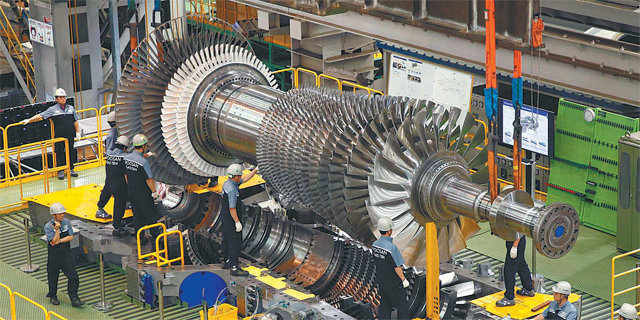Energy
Hanwha Impact develops 50% hydrogen gas turbine technology
South Korea sets a goal to expand the share of hydrogen and ammonia power generation to 7.1% by 2036
By Jun 22, 2023 (Gmt+09:00)
1
Min read
Most Read
LG Chem to sell water filter business to Glenwood PE for $692 million


Kyobo Life poised to buy Japan’s SBI Group-owned savings bank


KT&G eyes overseas M&A after rejecting activist fund's offer


StockX in merger talks with Naver’s online reseller Kream


Mirae Asset to be named Korea Post’s core real estate fund operator



The Ministry of Trade, Industry and Energy announced on Wednesday that Hanwha Impact Corporation, a South Korean petrochemical manufacturer, has developed technology to blend hydrogen up to 50% in medium-sized gas turbines.
Hanwha Impact held a Hydrogen Gas Turbine Power Generation Demonstration Ceremony at its Daesan plant in Seosan City, South Chungcheong Province, on the same day. A hydrogen-blended gas turbine is a power generator that mixes and combusts liquefied natural gas (LNG) and hydrogen to produce electricity.
In collaboration with Korea Western Power, Hanwha Impact has successfully developed the technology to mix hydrogen up to 50% in medium-sized LNG gas turbines (80 megawatts).
"Through this technological development, it has been shown that the emissions of carbon dioxide and nitrogen oxides, which are air pollutants, are reduced compared to conventional LNG gas turbines," said an official from Hanwha Impact.
In the future, Hanwha Impact plans to collaborate with West Incheon Combined Power Generation (150 MW), which is currently in commercial operation, to apply the blended power generation technology.
Amidst the global focus on reducing greenhouse gases and expanding the hydrogen ecosystem, mixing hydrogen in LNG power generation can help reduce carbon dioxide emissions. This approach has been proposed as a means of reducing greenhouse gases in nationally determined contributions (NDC) implementation plans and the basic national plan for power supply, along with nuclear power and renewable energy.
The Ministry of Trade, Industry and Energy expects that large-scale investments will continue in the establishment of domestic and international clean hydrogen production bases and fuel supply infrastructure.
"We plan to expand the share of hydrogen and ammonia power generation to 2.1% by 2030 and 7.1% by 2036," said Lee Ok-heon, the ministry's Director of Hydrogen Economy Policy, In his congratulatory speech at the ceremony. "I have high hopes for Korean companies to lead the hydrogen turbine market, given the expected rapid growth of the global hydrogen power generation market."
Write to Han-Shin Park at phs@hankyung.com
More to Read
-
 Shipping & ShipbuildingHanwha Group buys HSD Engine for $175.9 million
Shipping & ShipbuildingHanwha Group buys HSD Engine for $175.9 millionFeb 17, 2023 (Gmt+09:00)
1 Min read -

-
 Corporate rebrandingKorean oil refiners keen to change company names
Corporate rebrandingKorean oil refiners keen to change company namesNov 25, 2021 (Gmt+09:00)
2 Min read -
 Mergers & AcquisitionsHanwha seeks more M&A targets: Group’s heir apparent
Mergers & AcquisitionsHanwha seeks more M&A targets: Group’s heir apparentSep 10, 2021 (Gmt+09:00)
3 Min read
Comment 0
LOG IN


